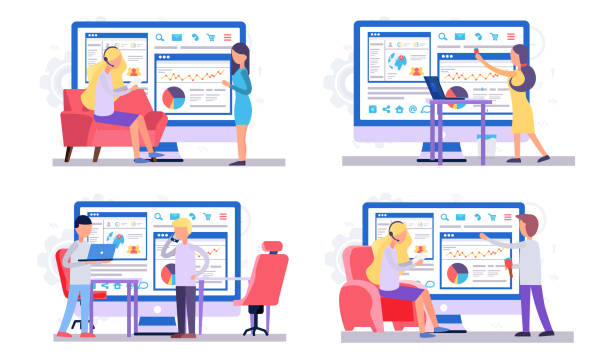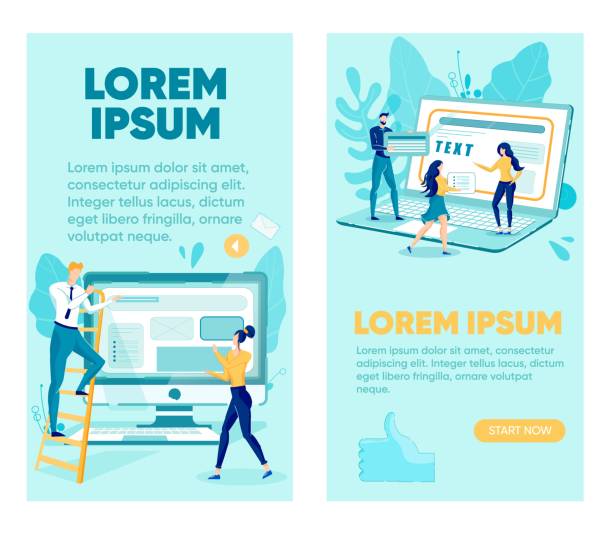Why Website Speed Matters? Its Impact on User Experience and SEO

In today’s digital world, where users expect information to be available at incredible speeds, #website_speed is no longer a competitive advantage, but an absolute necessity.
User Experience (UX) is heavily influenced by web page loading times.
Studies have shown that even a one-second delay in loading a page can lead to a significant decrease in conversions, customer satisfaction, and page views.
Users are impatient, and if your site is slow, they will quickly leave it and turn to your competitors.
This not only eliminates sales opportunities but also damages your brand’s reputation.
On the other hand, #SEO (Search Engine Optimization) is also increasingly paying attention to website speed.
Google and other search engines consider speed as an important factor in ranking search results.
Slower websites appear lower in search results, which means less visibility and reduced inbound traffic.
Therefore, for any online business, investing in fast website design is crucial to both provide an optimal user experience and achieve better search engine rankings.
This directly impacts return on investment and long-term success in the web space.
For this reason, any individual or company seeking an effective and successful online presence must seriously address the issue of website speed optimization and prioritize it.
This is a smart investment for your digital future.
Did you know that a poor corporate website loses many opportunities for you daily? Solve this problem forever with a professional corporate website design by Rasavab!
✅ Create a powerful and reliable image for your brand
✅ Attract targeted new customers and increase sales
⚡ [Get Free Website Design Consultation]
What is the Concept of Fast Website Design? Basic Principles and Benefits

The concept of fast website design goes beyond mere optimized coding; it is a comprehensive approach that encompasses all aspects of building and maintaining a website to ensure pages load in the shortest possible time.
The basic principles of this type of design include selecting appropriate infrastructure, optimizing front-end and back-end coding, using effective caching strategies, and optimizing content such as images and videos.
The main goal is to reduce server response time, decrease the volume of data sent to the user’s browser, and optimize the page rendering process.
One of the primary benefits of building a high-speed website is a significant improvement in user experience.
Users are more satisfied with websites that display content immediately and are more likely to spend more time on that site or convert into customers.
This directly relates to reducing bounce rate and increasing conversion rate.
Another advantage, as mentioned before, is the positive impact on SEO.
Search engines prefer fast websites and rank them higher in search results.
Also, a fast website consumes fewer server resources, which can reduce hosting costs.
Ultimately, fast website design helps create a professional and reliable brand image, as it shows that you care about details and customer experience.
This approach is vital not only for large businesses but also for personal websites and startups to establish their position in the competitive web space and achieve success.
In summary, speed is a decisive factor for online success in the current era, and web design should be approached with speed in mind from the outset.
Key Factors Affecting Website Loading Speed

Website loading speed is affected by multiple factors, understanding and optimizing which are crucial for fast website design.
These factors include various aspects from server infrastructure to page content and its coding.
The first important factor is hosting quality and server.
A slow server or shared hosting with limited resources can significantly increase response time.
Second, the size and optimization of images and videos: heavy media without proper compression can add tens of megabytes to the page size and slow down its loading.
Third, the use of a large number of HTTP requests and CSS/JS files: each separate file that the browser has to download creates an HTTP request, which adds to the loading time.
Fourth, unoptimized or render-blocking JavaScript and CSS codes: these codes can prevent the page content from displaying until they are fully loaded and executed.
Fifth, lack of caching: Caching allows the browser to store copies of static site files, so there is no need to re-download them on subsequent visits.
Sixth, database size and query speed: For dynamic websites, the speed of data access and processing in the database is also important.
Seventh, not using a Content Delivery Network (CDN): A CDN reduces the physical distance between the user and the server by distributing website content across multiple servers worldwide, increasing loading speed.
Eighth, the use of excessive plugins and scripts: every extra plugin or script imposes more processing load and HTTP requests on the site.
In the table below, some of the most important factors and solutions related to a fast-loading website are presented:
| Factor | Impact | Optimization Solution |
|---|---|---|
| Hosting Quality | Server response time | Choosing quality dedicated or VPS hosting |
| Image and Video Size | Increased page size | Compression, using next-gen formats (WebP), Lazy Load |
| JavaScript and CSS Codes | Render blocking, increased HTTP requests | Optimized coding, Minify, Defer or Async scripts |
| Lack of Caching | Increased unnecessary downloads | Activating browser and server caching |
Website Speed Measurement Tools and How to Analyze Reports

After understanding the factors affecting speed, the next step is to accurately measure your website’s speed and identify potential issues.
Fortunately, there are powerful and free tools available for this purpose that help you evaluate the performance of your speed-optimized website.
Among the most widely used tools are Google PageSpeed Insights, GTmetrix, Pingdom Tools, and WebPageTest.
Each of these tools provides comprehensive reports on website performance and assigns scores based on various criteria, such as initial loading speed, time to interactivity, and full loading time.
How to analyze these reports is very important; simply looking at the overall score is not enough.
You need to pay attention to the detailed sections of the report.
For example, PageSpeed Insights provides a list of “Opportunities” and “Diagnostics” that tell you which sections need optimization.
These can include things like image compression, removal of unused CSS/JS codes, rendering optimization, and reducing server response time.
GTmetrix, with its Waterfall Charts, also allows you to see individual HTTP requests and their loading times, which is very useful for identifying loading-blocking factors.
For fast website design, you should regularly use these tools and review changes after each optimization to ensure that your actions have had a positive impact on site speed.
Correct analysis of these reports helps you prioritize the tasks you need to do and effectively move towards a fast-loading website.
Did you know that 85% of customers check your company’s website before any interaction?
With Rasavab, build a corporate website that truly reflects your credibility.
✅ Increase credibility and customer trust
✅ Attract high-quality leads
⚡ Get Free Website Design Consultation
Optimizing Images and Media for Speed Increase

Images and media files typically constitute the largest portion of a web page’s size, and for this reason, optimizing them is one of the most crucial steps in fast website design.
If your images are not properly optimized, even with the best hosting and clean code, your site will still be slow.
The first step in image optimization is proper compression.
This means reducing file size without significant loss of quality.
Many online and offline tools are available for this purpose, such as TinyPNG, Compressor.io, or WordPress plugins like Smush.
Second, choose the appropriate image format: formats like JPEG are suitable for photographs, and PNG for images with transparency or logos.
However, using next-generation formats like WebP, developed by Google, can reduce image sizes by 25-35% more than JPEG or PNG, without compromising quality.
Third, resize images: ensure that the dimensions of your images are appropriate for their display area on the website.
Displaying an image with a width of 2000 pixels in a space that is only 500 pixels wide means loading extra and unnecessary data.
Fourth, implement Lazy Loading: This technique ensures that images and videos are only loaded when the user scrolls to the relevant section of the page.
This has a significant impact on initial loading speed, especially for long pages with a lot of image content.
Fifth, use CDN for media: As previously mentioned, a CDN can help speed up the delivery of images and other media files.
By observing these tips, you can significantly increase your website’s loading speed and provide a better user experience, which ultimately results in a successful fast website design.
The Importance of Hosting and CDN in Fast Website Design

Choosing an appropriate hosting service and using a Content Delivery Network (CDN) are two critical elements often overlooked in the fast website design process, yet they have an enormous impact on overall website performance.
Hosting is where your website files are stored and respond to user requests.
A powerful and optimized hosting minimizes the Time To First Byte (TTFB), which is the first and most important step in the page loading process.
There are different types of hosting, including shared hosting, VPS, dedicated server, and cloud hosting.
For small and new websites, shared hosting might be sufficient, but for high-traffic or commercial sites seeking fast website design, VPS or dedicated hosting is recommended as they guarantee more resources.
Also, choosing a geographical server location close to your target audience can increase speed.
On the other hand, a Content Delivery Network (CDN) is a system of distributed servers in various geographical locations that caches your website’s static content (such as images, CSS, JavaScript) and delivers it from the closest server to the user.
This significantly reduces latency and makes the website load quickly even for users in remote areas.
Using a CDN is especially necessary for sites with a global audience or heavy content and directly contributes to website speed optimization.
Services like Cloudflare or KeyCDN are examples of popular CDNs.
Combining quality hosting with an efficient CDN provides a strong foundation for any fast-loading website.
Reducing Codes and Scripts Has a Tremendous Impact on Website Performance

One of the specialized approaches in fast website design focuses on optimizing and reducing the size of CSS, JavaScript, and HTML codes.
These three main pillars of any website, if not managed correctly, can become the biggest obstacles to speed.
Every extra line of code, every unnecessary script, and every large CSS file adds to the page loading time.
The first step is Minification or code compression.
This process involves removing extra characters such as white spaces, new lines, comments, and unnecessary blocks from CSS, JavaScript, and HTML codes.
Although these changes seem minor to the human eye, they can significantly reduce file sizes.
Many automated tools are available for this purpose, which reduce code size without affecting functionality.
Second, Concatenation or file merging.
Instead of the browser downloading multiple CSS and JavaScript files separately, they can be combined into fewer files.
This reduces the number of HTTP requests and contributes to faster loading.
Third, JavaScript code management: JavaScript is often the main cause of site slowdowns due to its ability to block rendering.
By using `async` and `defer` attributes in script tags, it can be ensured that JavaScript loads asynchronously and does not prevent the display of the main page content.
Fourth, removing unused CSS and JavaScript codes: In many templates and plugins, there are codes that are not used on your current page but are still loaded.
Tools like Coverage in Chrome DevTools can help identify these codes so you can remove them or load them conditionally.
Fifth, optimizing the DOM structure: A complex DOM structure full of nested elements can slow down the rendering process.
By simplifying and optimizing the HTML structure, the browser can display the page faster.
Paying attention to these technical details is essential for achieving optimized website development in terms of speed.
The table below refers to some of the main techniques and their impact:
| Technique | Description | Impact on Speed |
|---|---|---|
| Minification | Removing white spaces and extra characters | Reduced file size, faster loading |
| Concatenation | Combining multiple CSS/JS files into one | Reduced HTTP requests |
| Async/Defer JavaScript | Asynchronous loading of scripts | Prevents page render blocking |
| Removing Unused Code | Identifying and removing unnecessary code | Reduced overall page size |
The Impact of Responsive Design and AMP on Speed and Mobile Experience

With the increasing use of mobile devices to access the internet, optimizing websites for mobile has become a priority.
In this regard, two concepts, Responsive Design and AMP (Accelerated Mobile Pages), play a key role in fast website design and providing a seamless experience for mobile users.
Responsive design means building a website whose appearance and functionality automatically adjust to the screen size of the user’s device, whether it’s a desktop computer, laptop, tablet, or smartphone.
This approach ensures that users have a positive experience regardless of their device type, and content is displayed correctly.
Although responsive design does not directly increase speed, by providing an optimal visual and functional experience, it is considered a positive factor by search engines and users, indirectly affecting SEO and conversion rates.
On the other hand, AMP is an open-source framework designed by Google to build extremely fast web pages for mobile devices.
AMP pages are built using restricted and optimized HTML, CSS, and JavaScript to load in a fraction of a second.
These pages often appear in Google’s mobile search results with a green lightning bolt icon and load almost instantly upon clicking.
Using AMP is very effective for news content and blogs and can significantly improve user experience and reduce bounce rates.
However, implementing AMP means maintaining two versions of a page (original and AMP version), which can introduce complexities.
The decision between responsive design and AMP (or combining them) depends on your website type and goals, but both are powerful tools for achieving fast web design and meeting the needs of mobile users.
These two concepts complement each other in website speed optimization.
Are your online sales not as expected? With Rasavab, solve the problem of low sales and poor user experience forever!
✅ Increase visitor-to-customer conversion rates
✅ Create an enjoyable user experience and boost customer trust
⚡ Act now to get a free website design consultation!
The Role of Caching and Compression in Improving Site Performance

Caching and Compression are two extremely powerful and essential techniques for anyone seeking fast website design.
These two methods directly impact reducing page loading time and improving overall website performance.
Caching means storing copies of your website’s static files (such as images, CSS, JavaScript, and even complete HTML pages), so they don’t need to be reloaded on subsequent user visits or repeated server requests.
There are various types of caching: browser caching, which stores files on the user’s computer; server caching, which keeps files in the server’s memory; and object caching, which stores database query results.
Proper use of caching, especially for websites with relatively static content, can dramatically reduce loading times and lighten the load on the server, resulting in a fast-loading website.
On the other hand, compression means reducing the size of files before sending them to the user’s browser.
The most common compression method is GZIP, which can reduce the size of HTML, CSS, and JavaScript files by up to 70%.
This reduction in size means less data transfer from the server to the user, leading to faster loading, especially for users with slower internet connections.
Most modern web servers like Apache and Nginx have the capability to enable GZIP compression.
Combining these two techniques – caching to prevent re-downloading files and compression to reduce the size of downloaded files – can have a profound impact on your website’s speed and significantly improve user experience.
Proper implementation of these techniques is a fundamental component of website speed optimization.
Future Challenges and Solutions in Fast Website Design

Despite significant advancements in fast website design and related tools, the path to achieving super-fast and efficient websites still faces challenges and requires innovative approaches and future solutions.
One of the biggest challenges is the increasing complexity of websites.
With the growth of JavaScript frameworks, the use of multiple APIs, and the addition of interactive features, the volume and complexity of codes are constantly increasing, making it difficult to maintain speed.
Another challenge is the diversity and dispersion of users and devices.
The need to provide a consistent and fast experience for users with different internet speeds and various devices (from old phones to powerful computers) is always a complex issue.
Cybersecurity can also affect speed; some security measures might slightly increase loading times.
In terms of future solutions, several innovations can be mentioned.
Further development of WebAssembly for high-speed execution of powerful code in the browser is one such case.
Also, advancements in network protocols like HTTP/3, built on QUIC, can minimize communication latency and contribute to a fast-loading website.
More widespread use of Microservices architectures for workload distribution and improved scalability can also aid speed.
The increasing role of artificial intelligence in web optimization tools, for automatic bottleneck identification and solution suggestions, brightens the future outlook.
On the other hand, awareness and education of web developers and designers about the importance and techniques of fast website design are fundamental factors for success in this field.
The future of the web is moving towards becoming faster and more optimized, and only websites that keep up with this trend can survive and grow in today’s competitive landscape.
This indicates that fast web design is a continuous and dynamic process.
Frequently Asked Questions
| Question | Answer |
|---|---|
| What is fast website design? | It refers to the process of building a website that is developed and launched in a short period, usually using ready-made platforms or optimized methods. |
| Why is speed important in website design? | High speed improves user experience, increases SEO ranking, and boosts the conversion rate of visitors to customers. |
| What tools are available for fast website design? | Content Management Systems (CMS) like WordPress, Joomla, and Drupal, drag-and-drop website builders, and fast web development frameworks. |
| What are the advantages of using a CMS for fast design? | Ready-made templates, diverse plugins, easy content management without extensive coding, and a large user community for support. |
| Does fast website design mean low quality? | Not necessarily. With appropriate tools and methods, a high-quality website can also be designed quickly. |
| What factors affect website design speed? | Project complexity, designer’s experience, choice of platform or appropriate tools, readiness of content and images, and effective communication with the client. |
| How is responsive design considered in fast website design? | Most fast design templates and tools are responsive by default and require little or no configuration. |
| How much does fast website design cost? | The cost varies depending on complexity, chosen platform, and additional services, but it is usually less than custom design from scratch. |
| How can the loading speed of a designed website be increased? | Image optimization, browser caching, file compression, using a CDN, and choosing suitable hosting. |
| When is fast website design a suitable option? | For small businesses, startups, personal websites, or projects that need quick launch and have a limited budget. |
And other services of Rasavab Advertising Agency in the field of advertising
Smart UI/UX: A creative platform to improve click-through rates with attractive user interface design.
Smart Marketing Automation: Professional optimization to increase sales using custom programming.
Smart Digital Branding: A combination of creativity and technology to improve SEO ranking through attractive user interface design.
Smart SEO: A combination of creativity and technology for campaign management through Google Ads management.
Smart Data Analysis: Designed for businesses looking to analyze customer behavior through Google Ads management.
And over hundreds of other services in the field of online advertising, advertising consulting, and organizational solutions
Online Advertising | Advertising Strategy | Advertorials
Sources
Digikala Mag: Website Design Optimization
Zoomit: Website Speed Increase Guide
Mizbanfa: Website Optimization Tips
Irandev: Fast Website Design
? Ready to leap your business forward in the digital world? Experience a bright future with Rasavab Afarin Digital Marketing Agency, specializing in secure website design and comprehensive online marketing strategies.
📍 Tehran, Mirdamad Street, next to Bank Markazi, Kazeroon Jonubi Alley, Ramin Alley, No. 6


